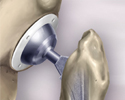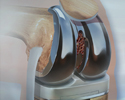Hip or knee replacement - in the hospital after
Hip replacement surgery - after - self-care; Knee replacement surgery - after - self-care
You will stay in the hospital for 1 to 3 days after having hip or knee joint replacement surgery. During that time, you will recover from your anesthesia and the surgery.
Right After Surgery
Even though your surgeon may talk to your family or friends right after surgery is done, you will still spend 1 to 2 hours after surgery in a recovery room before going to your room. You will likely wake up tired and groggy.
You will have a large dressing (bandage) over your incision (cut) and part of your leg. A small drainage tube may be placed during surgery to help drain blood that collects in your joint after surgery.
Back in Your Room
You will have an IV (a catheter, or tube, that is inserted into a vein, most often in your arm). You will receive fluids through the IV until you are able to drink on your own. You will slowly resume a normal diet.
You may have a Foley catheter inserted into your bladder to drain urine. Most of the time, it is removed the day after surgery. You may have some trouble passing your urine after the tube is removed. Make sure you tell your nurse if you feel that your bladder is full. It is helpful if you can walk to the bathroom and urinate in the normal fashion. You may need to have the tube put back in to help drain the bladder if you can't urinate for a while.
Your surgeon will show you how to prevent blood clots.
- You may wear special compression stockings on your legs. These stockings improve blood flow and reduce your risk of getting blood clots.
- Most people will also receive blood-thinning medicine to further reduce the risk of blood clots. These medicines can make you bruise more easily.
- When you are in bed, move your ankles up and down. You will also be taught other leg exercises to do while you are in bed to prevent blood clots. It is important to do these exercises.
- You may also have leg wraps or foot pumps that squeeze your leg periodically when you are lying in bed. This also helps blood flow and reduces the risk of blood clots.
You may be taught how to use a device called a spirometer and do deep breathing and coughing exercises. Doing these exercises will help prevent pneumonia.
Your provider will prescribe pain medicines to control your pain.
- You can expect to have some amount of discomfort after surgery. The amount of pain varies from person to person.
- You may receive pain medicine through a machine that you can use to control when and how much medicine you receive. You will receive the medicine through an IV, oral pills, or a special tube placed into your back during surgery.
- You may also have a nerve block placed during surgery, which may be continued after surgery. Your leg may feel numb and you may not be able to move your toes and ankle for the first day. However, sensation and function should recover before you leave the hospital. Make sure you talk with your surgeon before and after surgery to make sure that your sensation is normal.
You may also be prescribed antibiotics to prevent infection. In most cases, you will get these medicines through an IV while you are still in the hospital.
You Will be Encouraged to Start Moving and Walking
Your health care providers will encourage you to start moving and walking.
You will be helped out of bed to a chair on the day of surgery. You may even try to walk if you feel up to it.
You will work with specialists to get moving again and to learn to take care of yourself.
- A physical therapist will teach you exercises and how to use a walker or crutches.
- An occupational therapist will teach people who have had hip or knee replacement how to safely perform daily activities.
All of this takes a lot of hard work on your part. But the effort will pay off in the form of a faster recovery and better results.
By the second day after surgery, you will be encouraged to do as much as you can by yourself. This includes going to the bathroom and taking walks in the hallways with help.
After knee replacement, some surgeons recommend using a continuous passive motion machine (CPM) while you are in bed. The CPM bends your knee for you. Over time, the rate and amount of bending can be adjusted to increase them. If you are using this machine, always keep your leg in the CPM when you are in bed. It may help speed your recovery and reduce pain, bleeding, and risk of infection.
You will learn the proper positions for your legs and knees. Make sure you follow these guidelines. Improper positioning can injure your new hip or knee joint.
Getting Ready to go Home
Before you go home, you will need to:
- Be able to move or transfer in and out of bed, in and out of chairs, and off and on the toilet without help and safely
- Bend your knees almost to a right angle or 90° (after knee replacement)
- Walk on a level surface with crutches or a walker, without any other help
- Walk up and down some steps with help
Some people need a short stay in a rehabilitation center or a skilled nursing facility after they leave the hospital and before they go home. During the time you spend here, you will learn how to safely do your daily activities on your own. You will also have time to build strength while you recover from your surgery.
References
Harkess JW, Crockarell JR. Arthroplasty of the hip. In: Azar FM, Beaty JH, eds. Campbell's Operative Orthopaedics. 14th ed. Philadelphia, PA: Elsevier; 2021:chap 3.
Mihalko WM. Arthroplasty of the knee. In: Azar FM, Beaty JH, eds. Campbell's Operative Orthopaedics. 14th ed. Philadelphia, PA: Elsevier; 2021:chap 7.
Review Date: 8/12/2023
Reviewed By: C. Benjamin Ma, MD, Professor, Chief, Sports Medicine and Shoulder Service, UCSF Department of Orthopaedic Surgery, San Francisco, CA. Also reviewed by David C. Dugdale, MD, Medical Director, Brenda Conaway, Editorial Director, and the A.D.A.M. Editorial team.



